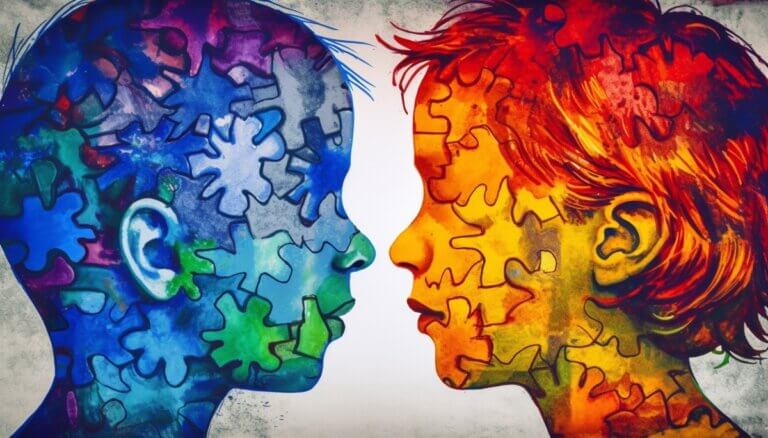Table of Contents
Emotional Intelligence in Intercultural Context

Cultural Differences in Emotional Intelligence
Emotional Intelligence – a term interpreted and practiced differently across various cultures. The influence of cultural conditioning on our ability to perceive, understand, and manage emotions in ourselves and others is immense.
Cultural Emotional Intelligence and Its Effects
Consider situations in the international business environment. An Asian manager might be reserved about expressing his opinion directly to avoid confrontation – an approach often linked to respect in Asian cultures. However, this reservation might lead to misunderstandings with Western business partners who are accustomed to openness and directness. This reveals the core of cross-cultural Emotional Intelligence: the ability to appropriately interpret emotions within a cultural context and adjust accordingly.
- A broad smile may be seen as a sign of friendliness and openness in the USA, whereas in Japan it might also express discomfort.
- The use of silence during a conversation is often viewed as constructive and thoughtful in Scandinavia, while in South American countries, it might be seen as disinterest.
- In many Western cultures, eye contact is interpreted as confidence and honesty, whereas in other cultures, it may be seen as a challenge to authority or impoliteness.
Developing Cultural Emotional Intelligence
Cultural Emotional Intelligence doesn’t develop overnight. It requires a profound understanding of the underlying cultural dynamics and a continuous effort to recognize and adjust our own interpretive filters. It necessitates a conscious engagement with cultural differences in Emotional Intelligence and a consistent learning process to navigate diverse social landscapes.
- Experienced in intercultural communication through travel, language skills, and social interactions.
- Be mindful of the cultural norms and values of interaction partners.
- Developing empathy to better understand the perspective of others.
At its core, cross-cultural Emotional Intelligence is about the readiness and ability to recognize our own emotions and those of others, even when cultural signals differ from those we intuitively understand.
Impact on Interpersonal Relationships
Cultural influences on Emotional Intelligence have far-reaching effects on interpersonal relationships – both private and professional. A deep understanding and flexible adaptation to the emotional landscape of another culture can lead to successful business deals, fruitful negotiations, or harmonious private relationships. Ignorance of these differences, however, can lead to conflicts, misunderstandings, and severed communication channels.
The ability to look beyond our own cultural horizon and tune into the emotional world of another is one of the key skills of the 21st century. It is vital not just for the individual but for our globalized society. Understanding and applying Emotional Intelligence in its cross-cultural dimension is a challenge that we all should embrace.
Influence of Cultural Context on Emotional Competence
Emotional Intelligence (EI) is the ability to perceive, interpret, and appropriately respond to one’s own and others’ emotions. This concept has garnered much attention over recent decades, but how does cultural background affect this crucial competence? ‘Cultural Emotional Intelligence’ expands the traditional understanding of EI by considering the influence of cultural values and norms on emotional experience and behavior.
Cultural Differences in Emotion Perception
In different cultures, emotions are expressed and evaluated differently. What is seen as a sign of strength in one culture may be interpreted as weakness in another. For example, direct eye contact is considered a sign of trust in many Western societies, while it may be viewed as inappropriate or disrespectful in some Asian cultures. ‘Emotional Intelligence Cultural Differences’ show that someone with high cultural emotional intelligence is able to recognize these nuances and adjust their behavior accordingly. This requires a deep understanding of both one’s own emotional patterns and those of the other culture.
- Research shows that people from collectivist societies tend to assess emotions more in the context of group harmony, whereas in individualistic cultures, personal authenticity and self-expression hold higher value.
- Studies have also found that emotion regulation is practiced differently across cultures; some cultures tend to suppress negative emotions, while others express them openly.
- The interpretation of nonverbal signals can also vary greatly. What is considered a friendly smile in one culture may be perceived as an expression of insincerity in another.
Developing Cross-Cultural Emotional Intelligence
The importance of ‘Cross-Cultural Emotional Intelligence’ cannot be overstated, especially in a globalized world where we interact daily with people from different cultures. It involves not just learning other languages and customs, but rather achieving a deeper level of emotional understanding and respect.
Practical examples can be found in business, where awareness of cultural differences in emotion regulation can lead to successful negotiations. For instance, a manager might notice that a foreign business partner does not express criticism directly, even though it is present. In this case, it would be important to recognize subtler signals and respond to them.
Moreover, creating an inclusive environment at the workplace, in schools, or in the community is crucial to positively integrating ‘Cultural Influences of Emotional Intelligence’. Workshops and training sessions can help raise awareness of cultural differences in processing and expressing emotions.
To increase cultural EI, the following strategies should be considered:
- Active listening and observing to better understand how emotions are expressed in different cultures.
- Openness and willingness to learn from other cultures and to reflect on one’s own emotional reactions.
- Developing empathy to understand and respect emotions across cultural barriers.
‘Cultural Emotional Intelligence’ enriches our ability to interact with people from various backgrounds, fostering mutual understanding and harmonious coexistence. By learning to sharpen our emotional perception across cultural boundaries, we not only enhance our personal competence but also contribute to a respectful coexistence in a diverse world.
Application of Emotional Intelligence in Multinational Companies

The Importance of Emotional Intelligence for Leaders in an International Environment
Emotional intelligence is the invisible wheel that drives the efficiency of international leadership teams. The ability to recognize, understand, and manage one’s own and others’ emotions plays a particularly crucial role in an environment with diverse cultural backgrounds.
The premise of cultural Emotional Intelligence is that successful leadership relies not only on professional competencies but significantly on the empathetic bridge between cultures. For instance, consider a German manager leading a team in Singapore: The direct and task-oriented communication, often appreciated in Germany, can be perceived as harsh and disrespectful in Singapore. Here, a high degree of Emotional Intelligence Cultural Comparison is required to balance the nuances in expression and feeling across cultural spheres.
Cross-Cultural Emotional Intelligence
The value of this ability is impressively demonstrated when conflicts need to be resolved. Emotional intelligence allows leaders to identify tensions before they escalate. A team member from South America might avoid confrontation and not openly express disagreements. Without knowledge of such Cultural Influences of Emotional Intelligence, important signals might be overlooked.
Cultural Emotional Intelligence requires a profound reflection on one’s own prejudices and stereotypes. Emotional Intelligence Cultural Differences also involve understanding and adapting to different feedback and motivation mechanisms. Cross-cultural Emotional Intelligence means developing a sensitivity for the communicative nuances of each cultural sphere.
Practical Examples and Cultural Finesse
Imagine a video conference: A team member from Japan soberly shares his project progress. The restrained presentation can mistakenly be interpreted as a lack of enthusiasm or commitment. A leader with high Emotional Intelligence would not make premature judgments, but rather consider the cultural norms that promote modesty and restraint.
Thus, harmonious cooperation in international teams depends not only on strategic foresight and organizational skills but also on a sensitive, intuitive competence that values cultural emotions and uses them to strengthen team spirit. To lead with emotional intelligence means to celebrate human diversity and see it as a source of innovation and creativity.
Emotional intelligence in international management is thus not just a “Nice-to-have,” but an essential part of leadership competence that can build bridges across borders and advance the common vision. It is the key to creating a corporate culture based on trust, respect, and a deep understanding of the multifaceted shades of human emotions.
Training and Development of Emotional Intelligence in Organizations
Emotional Intelligence (EI) is a key component for success within the workplace – especially in a complex, international environment. The ability to recognize, understand, and manage emotions in oneself and others is essential in multicultural organizations. Cultural Emotional Intelligence enables bridging cultural differences and building effective interpersonal relationships.
Cultural Influences on Emotional Intelligence
A fundamental understanding of Cross-Cultural Emotional Intelligence implies correctly interpreting emotional signals from different cultures and responding appropriately. For example, a smile might signify friendliness in one culture, while in another it could be seen as a sign of insincerity. Therefore, a Cultural Comparison of Emotional Intelligence plays a crucial role in designing international training programs.
- The design of training approaches must be based on a deep understanding of Cultural Emotional Intelligence differences. This includes how emotions are expressed and interpreted across different cultural spaces.
- A central element is the sensitization to nonverbal communication and its varying meanings. Often, this is where the biggest challenges in an intercultural context lie.
- Practical exercises that encourage reflection on one’s emotional patterns while simultaneously sharpening understanding of foreign emotional worlds are part of effective training programs.
Best Practices for Emotional Intelligence Training
Successful organizations that focus on developing emotional intelligence in their training program are characterized by several best practices. Here, regular evaluation of these trainings is essential to ensure they are tailored to the needs of a globally diversified workforce.
- Case studies and role plays based on real situations help employees recognize cultural subtleties and critically reflect on their own emotional reactions.
- Involving multicultural teams in the development of training materials ensures that various perspectives and expectations are considered.
- To measure the success of such trainings, assessment tools are available that analyze not only individual EI but also team effectiveness in culturally diverse teams.
The deployment of targeted Emotional Intelligence training can significantly enhance employee motivation and improve the collaborative work atmosphere. Here, Cultural Emotional Intelligence plays a central role in promoting intercultural competence within globally operating organizations and contributing to sustainable business success.
Summary
Emotional Intelligence (EI) is a core competency for success in an increasingly globalized world. Particularly the cultural aspects of Emotional Intelligence play a crucial role, as they enable us to bridge cultural differences and maintain effective interpersonal interactions. Cultural Emotional Intelligence is the advanced ability to competently interpret and respond to emotional signals – across one’s own cultural boundaries. It is crucial for collaboration in multicultural teams and in international business relations.
Understanding Cultural Influences on Emotional Intelligence
A deep understanding of cross-cultural Emotional Intelligence is an essential component to effectively communicate and interact in different cultures.
- Emotions and their nonverbal expression, such as smiling or eye contact, can be interpreted differently depending on the culture.
- A heightened awareness of Emotional Intelligence cultural differences helps to avoid misunderstandings and build trust.
- Developing a cross-cultural perspective requires openness, adaptability, and a willingness to learn from each other.
Practical Implementation in the Work Context
In the international environment, Emotional Intelligence in cultural comparison takes a central position. Leaders and teams that train this competency facilitate cooperation and optimize team performance.
- Culturally sensitive communication and the proper handling of feedback are keys to avoiding conflicts.
- Recognizing and appreciating cultural differences can contribute to motivational enhancement within international teams.
- Specialized training programs in cultural Emotional Intelligence strengthen the intercultural competence of employees.
The concept of emotional intelligence goes beyond the knowledge of emotions; it includes the ability to adapt emotional knowledge and apply it in the context of different cultural circles. This adaptability has far-reaching effects on professional and private interpersonal relationships. It improves the working atmosphere, supports business success, and promotes personal growth. By expanding and refining our emotional abilities, we contribute to a better global coexistence and solidify the foundation for successful and respectful collaboration.
FAQ – Cultural Aspects of Emotional Intelligence
How do cultural differences influence the perception and expression of emotional intelligence?
Cultural differences significantly shape how we interpret and express emotions, as each culture has its own norms and rules for emotional behavior. For instance, in some Asian cultures, the restrained expression of emotions may be seen as a sign of strength and control, whereas in Mediterranean or Latin American societies, passion and expressiveness are highly valued. Emotional intelligence in an intercultural context thus requires the ability to understand these cultural codes and adjust one’s behavior accordingly, to avoid misunderstandings and enable effective communication.
How does the perception and manifestation of emotional intelligence differ across cultures?
Emotional intelligence, understood as the ability to recognize and manage one’s own and others’ emotions, manifests differently across cultures, as norms, values, and social expectations shape how emotions are expressed and interpreted. While some societies value openness and direct expression of emotions, other cultures prefer more subtle forms of emotional communication. This leads to variations in strategies for emotion regulation and the interpretation of social signals depending on the cultural context.
How does the expression of emotional intelligence differ between individualistic and collectivist cultures?
In individualistic cultures, the focus of emotional intelligence often lies on self-awareness and self-regulation, as the individual strives to achieve personal goals and express their own needs. In collectivist cultures, on the other hand, emphasis is placed on social harmony and interpersonal relationships, which means that skills such as empathy and social responsibility are more emphasized to meet the needs of the group. Thus, it is evident that cultural orientation has a significant influence on the aspects and practices of emotional intelligence.




